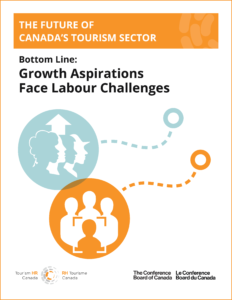 Canada’s tourism sector has the potential for significant growth in the coming decades, as both a contributor to the economy and a source of employment for Canadians. However, a key hurdle persists: the labour challenges tourism operators face, especially in rural and remote regions.
Canada’s tourism sector has the potential for significant growth in the coming decades, as both a contributor to the economy and a source of employment for Canadians. However, a key hurdle persists: the labour challenges tourism operators face, especially in rural and remote regions.
Sixty-three percent of tourism businesses report that labour issues are a struggle for their business, with problems ranging from difficulty finding qualified staff, to local labour shortages, to difficulty retaining reliable employees.
As Canada’s source for tourism labour market intelligence, Tourism HR Canada is pleased to announce the release of the latest update of its tourism labour supply and demand study, The Future of Canada’s Tourism Sector – Bottom Line: Growth Aspirations Face Labour Challenges. The study quantifies the implications of long-term demographic and economic trends on the supply and demand for labour in Canada’s tourism sector.
The full report is now available on our emerit.ca website. The national summary is available as a free download on tourismhr.ca.
Key Facts:
- In 2015, the Job Vacancy and Wage Survey showed there were 22,320 vacant full-year jobs in Canada’s tourism sector.
- Spending by tourists and residents in Canada’s tourism sector could reach $338 billion by 2035, requiring 2.3 million jobs to meet that demand.
- The past few years have seen an increase in the number of immigrants coming to Canada each year. This policy change has mitigated the number of jobs expected to go unfilled, but it has not eliminated the labour shortfall facing tourism.
- By 2035, the tourism sector could see 93,000 full-year jobs go unfilled, equal to $10.1 billion in potential revenue.
The bottom line is that labour challenges are impeding the growth of the sector. The results show that labour challenges are a real barrier and reducing the tourism sector’s growth potential. The consequences of labour shortages, such as lack of investor interest in the sector and the inability of tourism businesses to meet demand, could cost Canada billions of dollars.
While the outlook may seem bleak, the projected shortfalls are not inevitable. The projections assume that the attractiveness of tourism occupations, job responsibilities, wages, and access to training and education programs will remain constant. This will not necessarily be the case.
Action on the part of governments, the sector as a whole, and individual businesses can significantly increase the number of available tourism workers. This is demonstrated by an addition to this year’s report, which examines the impact of the increases to annual immigration intakes (announced in November 2017). This counterfactual scenario demonstrates how policy decisions can affect labour market outcomes. While the sector is still faced with finding people to fill 93,000 tourism jobs, higher immigration means the shortage outlook is much less acute than it was in 2015. Over the forecast horizon in this report, that policy change is expected to fill 44,000 tourism jobs that would have otherwise gone unfilled.
While this report focuses on the future of demand and supply of labour in the tourism sector, it also examines several other subjects, including the results of the 2018-19 Tourism Outlook and Labour Issues Survey, potential job openings in tourism, and the effect of the sharing economy on tourism. Look for more information in coming issues of Tourism HR Insider.

